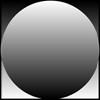Looking for design inspiration? Browse our curated collections!
April 17th, 2017 - 10:26 AM

Figure-Ground Reversal in the Brain.
One thing I always look for in any picture is whether the "figure" swaps light and dark values with the background. I call this effect reverse-gestalt and it lends depth to any image, representational or abstract. It's like a ball of ying-yang in a box of flip-flop.
Take my pen and ink version of Ed Munch's "The Scream" for example. The guy in this picture sports a dark frock that stands out on the light-colored bridge while his big ol' head sticks out - light on dark - like a molar over troubled waters. Yet, we see his head and body as a single figure above all. Your brain has to work a little harder to integrate these pictorial elements but it provides an aesthetic payoff, an extra kick in the mental pants so to speak.
And it doesn't have to be a wholesale inversion. To find even a small region that reverses polarity is like switching-on an electrical circuit that charges a picture with an alternating current. Reverse-gestalt packs its perceptual punch by making the viewer subliminally "do the math" in his or her head. It works the same way as subtle innuendo does in a joke, such as "an Abstract Expressionist-style painting entitled 'Drop Cloth.'"
Highlights and shadows are well suited for the gestalt effect. That's why late one night, as we emerged from the hot tub on the observation deck here at The Peterson Institute, I suggested to my lovely associate and research partner, Elise, that she strike a pose (dishabille, if you get my drift) on the patio where her statuesque contours would be grazed by the backyard spotlight as it spilled on yonder privacy fence, thereby highlighting her classic figure against a stark shadow on one hand, and its silhouette over an incandescent backwash on the other, while I whipped off a quick sketch to illustrate said modeling effect for this article. But she nixed my big idea, hence The Scream instead.
Anyhow, before we dive into the brain, let me get some fancy words out of my system: Lateral geniculate nuclei, superior colliculus, and occipital lobe. Thank you.
Drawing is called the art of omission. The lines and shadings are a kind of visual shorthand for objects, real or imagined, to be "read" by a mechanism of brain cells...
...(Read the rest of this essay in The Intellectual Handyman On Art, a new book by Gary R. Peterson from iUniverse.)
Comments
There are no comments on this blog. Click here to post the first comment.